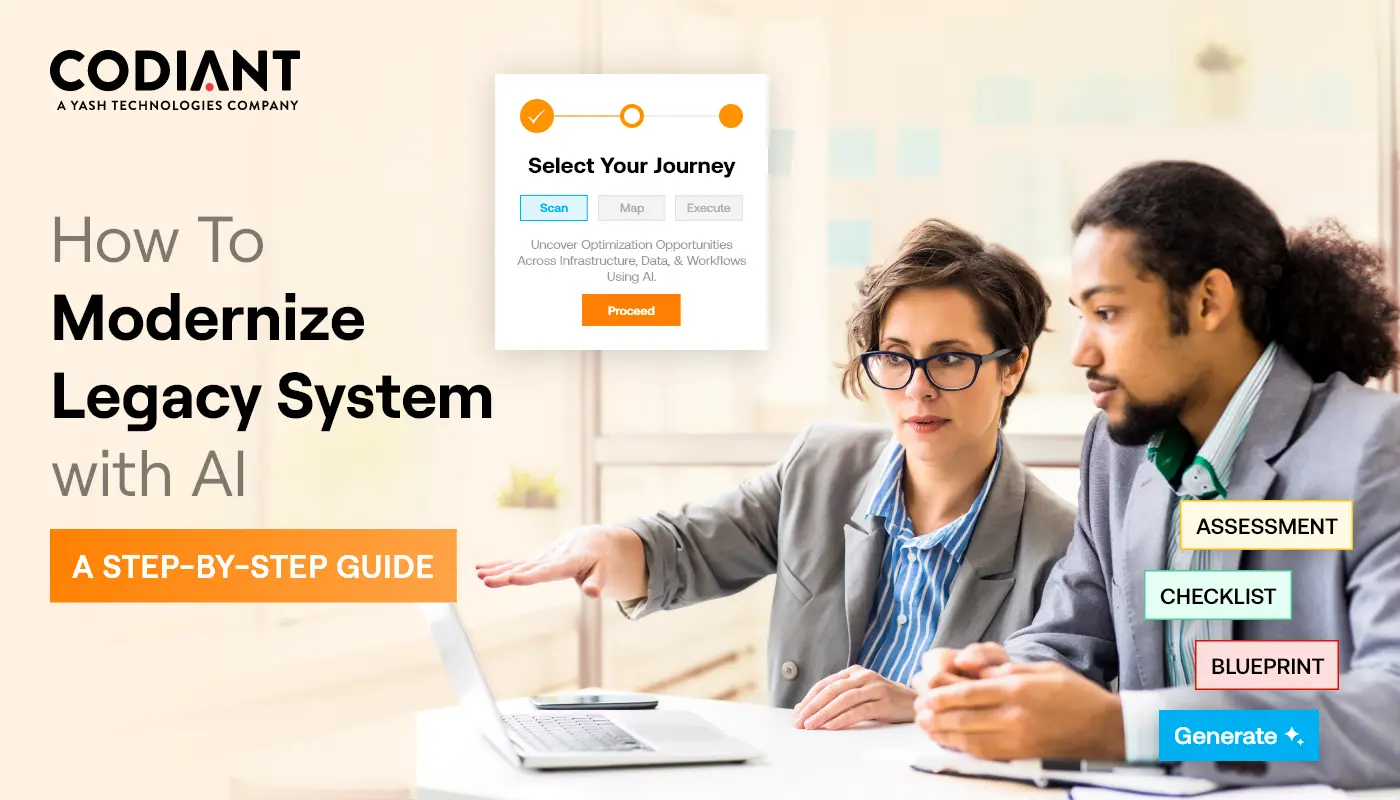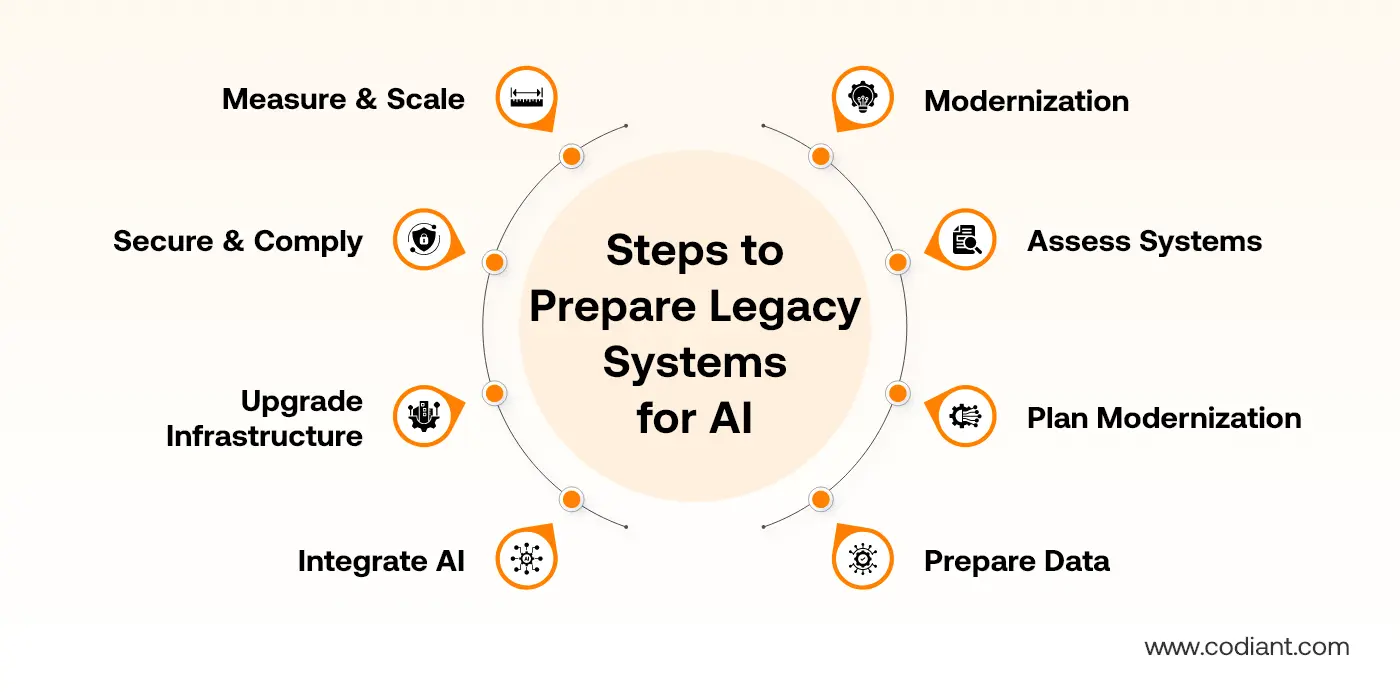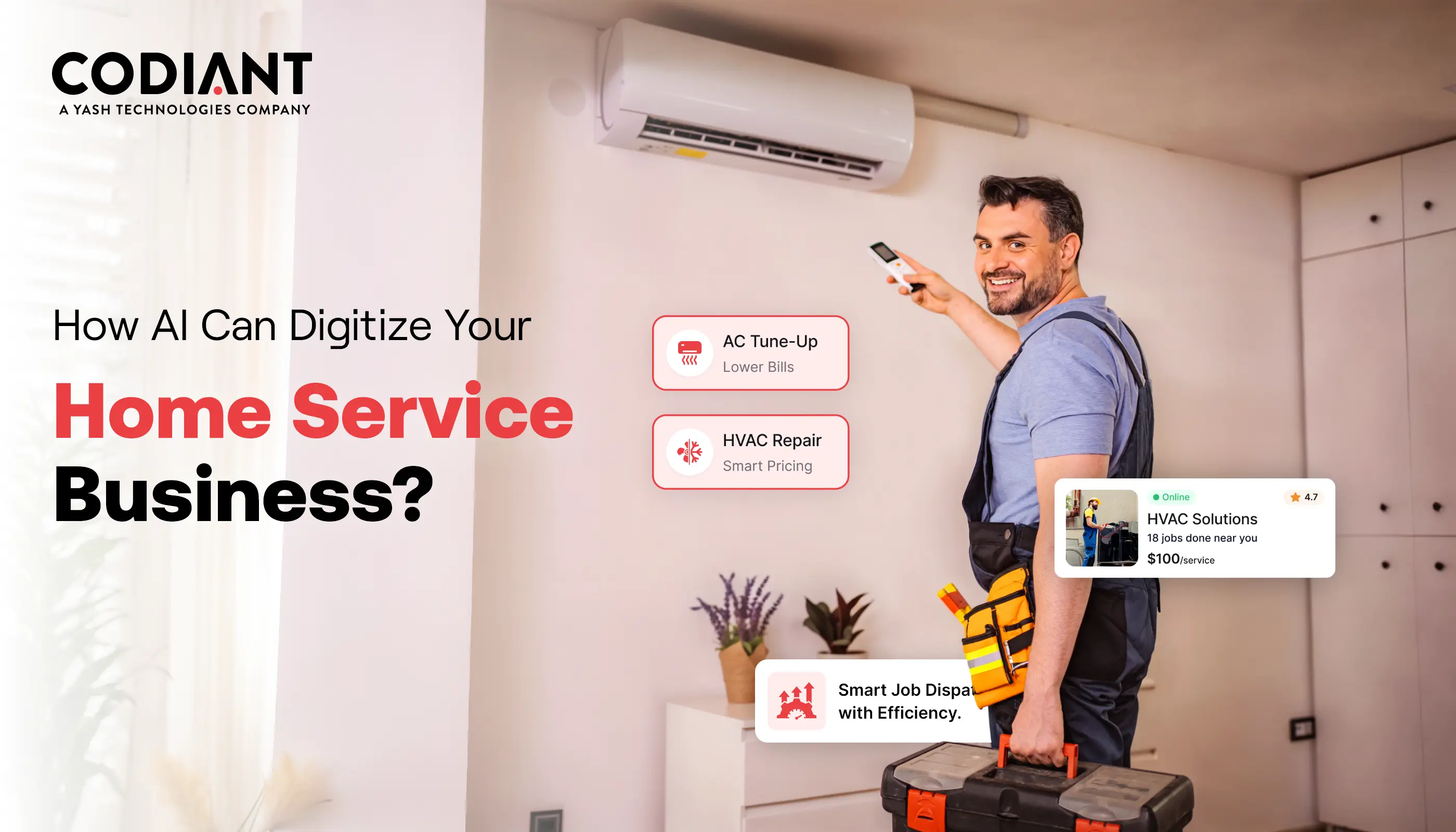How to Modernize Legacy Systems with AI – A Step-by-Step Guide
Table of Contents
Subscribe To Our Newsletter

In a Nutshell:
- Legacy systems aren’t outdated – they’re underutilized. AI can modernize them without full replacement, saving time and cost.
- Modernization is a journey, not a rebuild. Start small with automation, data clean-up & gradual AI integration.
- Clean data = smart AI. Preparing accurate, unified data is the foundation of every successful AI project.
- Step-by-step transformation works best. From assessing systems to upgrading infrastructure and tracking results, each stage builds momentum.
- Security and compliance come first. Modernization must include strong data protection and transparent AI governance.
- Real-world results prove the impact. AI-led modernization can cut operational costs by up to 30% and improve customer satisfaction dramatically.
- The future belongs to AI-ready enterprises. Businesses embracing predictive, agentic & RAG-powered systems today will lead tomorrow’s digital economy.
Across industries – from banking and insurance to healthcare and retail- many companies still use systems-built decades ago. These legacy systems, once advanced, have now become quiet blockers that slow digital growth. They store important data but lack the flexibility to change and improve.
That’s where AI in legacy modernization comes in – a powerful way to mix the stability of old systems with the intelligence and speed of modern technology. Companies can handle repetitive tasks automatically with AI-powered automation in legacy systems, which helps in making smarter decisions & work faster without rebuilding everything from the ground up.
This change is not just about replacing everything overnight- it’s actually about improving what already works by adding the power of AI. Let’s see how businesses can follow a simple, safe & step-by-step path to move from old systems to AI-driven success.

What Are Legacy Systems?
Legacy systems are old computer programs that companies still use to run their work. They were built many years ago using old technology. For example, some banks still use old software that runs only on their own computers instead of the cloud. These systems worked great in the past, but now they can’t easily connect with new apps or handle modern technology needs.
Keeping these old systems running costs more than just money. They slow down business growth, cause frequent downtime and make it hard to use new technologies like AI, machine learning or predictive tools.
The challenges of AI adoption in legacy systems are many-
- Data silos- Information sits in different places and doesn’t connect.
- Rigid architecture- The system isn’t flexible enough to add AI tools easily.
- High maintenance costs- Constant fixes take up time and budget that could be used for updates.
- Skill gaps- Teams who understand old code often don’t know how to work with AI or cloud tools.
The vast majority of IT budgets are still locked into old technology, according to Gartner. Now, forward-thinking enterprises are leveraging AI-infused modernization to alleviate this burden and speed innovation.
Turn Legacy Limitations into AI Opportunities
Stop letting outdated systems hold you back. Discover how AI modernization can cut inefficiencies, automate workflows & accelerate business growth.
How to Prepare Your Legacy Systems for AI Modernization

The first stepping stone to building a smarter future is equally as important- where you must build (or update) your legacy architecture, data quality and infrastructure before you can achieve the AI transformation.
Step 1 – Check Your Current System and Business Needs
Before updating your old systems, start by doing a full check of your current IT setup. This review should look at-
• How different systems depend on each other and how workflows run.
• How easily your system connects with other apps.
• Any slow spots, crashes or downtime issues.
• The quality of your data and how it’s stored.
During this check, see where AI-powered automation in legacy systems can bring improvements. For example-
• Predictive maintenance in manufacturing.
• Customer loss prediction in telecom.
• Fraud detection in banking and finance.
Use a simple checklist to decide what’s most important-
• Is your system ready to work with APIs?
• Can your databases work with AI tools?
• Do you have clean, labeled data for AI and machine learning?
• Are there security or rule-related gaps that modernization must fix?
This early step makes sure your modernization plan supports business goals, not just technology changes.
Step 2 – Choose a Modernization Plan
After reviewing your system, decide if you want to modernize bit by bit or do a full upgrade.
Step-by-step modernization brings fast wins by adding AI-powered automation in legacy systems without rebuilding everything.
Examples include-
• Using RPA (Robotic Process Automation) to handle repetitive work.
• Adding AI chatbots to old CRM systems to answer customer questions.
• Building APIs to share data between old and new software.
This approach lowers risk, avoids downtime & gives a quick return on investment.
A full transformation means rebuilding your system for the cloud with AI-ready technology. It costs more and takes time but gives long-term flexibility and innovation.
Some companies pick a hybrid model-they move apps to the cloud first and then slowly rebuild key parts for AI in legacy modernization.
The goal is to balance cost, business continuity & long-term benefits.
Step 3 – Prepare Your Data- The Core of AI Success
Data is the center of every AI project. But old systems often have messy data – missing details, wrong formats, or repeated records.
Before using AI, make sure your data is clean and correct.
- Clean and organize- Fix errors and use one common format.
- Move safely- Store your data in the cloud or a secure system.
- Automate- Use tools that can collect and clean data automatically.
Keep all your data in one place, like a data lake or warehouse. Follow safety rules such as GDPR or HIPAA if the data is private.
Clean data helps AI make better, fair & more accurate decisions. Remember- AI works only as well as the data you give it.
Step 4 – Add AI Features to Your Existing Applications
This is where you make your old systems smarter. You don’t need to build everything again – just add AI features.
You can connect AI tools using small add-ons or APIs. For example-
- Chatbots that answer customer questions quickly.
- Prediction tools that help plan future sales or demand.
- AI cameras that check product quality in factories.
AI can help reduce manual work, improve accuracy & speed up results. For example, AI can find product issues in seconds, saving both time and money.
When adding AI-
- Make sure all systems work well together.
- Use APIs so data can move easily.
- Keep your setup ready for future AI updates.
Adding AI features step by step helps your systems grow smarter and work faster.
Step 5 – Upgrade Infrastructure – Cloud, Containers & APIs
Strong infrastructure is the base for all AI success. Older systems on physical servers are hard to scale or update. Moving to the cloud gives flexibility, security & faster AI performance.
Important upgrades include-
- Cloud migration- Move workloads to AWS, Azure or Google Cloud.
- Containerization- Use Docker or Kubernetes to update and manage apps easily.
- API enablement- Turn old functions into APIs so they connect well with AI tools.
- Serverless computing- Let systems adjust automatically based on demand.
These upgrades make your setup modern and ready for AI-driven growth. They also help connect with technologies like IoT, RPA or GenAI. With this, your company stays flexible, scalable & future-ready.
Step 6 – Keep Systems Secure, Compliant & Well-Governed
Modern systems need modern security. Adding AI also brings new risks-external APIs, cloud sharing & big data transfers. So, protect everything from the start with smart security.
Follow these key steps-
- Encrypt data- Keep it safe when stored or shared.
- Use IAM tools- Let AI watch for strange logins or user behavior.
- Stay compliant- Follow laws like GDPR, HIPAA & PCI-DSS.
- Use AI threat detection- Catch and stop attacks early.
In sensitive fields like banking or healthcare, AI can even help track compliance rules and prepare reports automatically. Good governance also means AI decisions must be transparent and fair, especially in areas like credit scoring, hiring or healthcare.
Step 7 – Track Results, Improve & Scale AI Across the Business
Your job isn’t done once AI is running. Keep checking how it’s working and make it better over time.
Watch important results like-
- Less manual work
- Systems staying online more often
- Money saved through automation
- More accurate AI predictions
As new data comes in, update your AI models so they keep learning and improving. Tools like MLOps make it easy to track, test & update AI systems.
When you start seeing good results, expand AI to other teams. HR can use it for onboarding, logistics can plan deliveries smarter and marketing can create personal offers for customers.
By improving AI little by little, your company turns digital modernization into a steady journey of growth and innovation.
Read More: Cost To Develop A Digital Transformation Strategy For US Businesses
Common Mistakes to Avoid During AI Modernization
Even though AI can make systems smarter, many projects face problems because of simple mistakes. Here are the most common ones to avoid-
- Not Understanding Your Data
Old system data is often messy or incomplete. If you skip cleaning it, your AI will give wrong results. Always organize and fix your data first. - Forgetting to Train Employees
People who use the system must understand how the new AI tools work. Give them proper training and explain the changes clearly. - Changing Everything Too Fast
Trying to replace all systems at once can cause big problems and downtime. Start small, test what works & then expand slowly. - Not Making AI Decisions Clear
AI should be able to explain why it made a certain decision. If people can’t understand it, they won’t trust it – especially in areas like banking or healthcare. - Ignoring Hidden Costs
Connecting AI to old systems takes time and money. You’ll need to spend on APIs, data transfer & system setup. Plan your budget carefully.
With good planning and teamwork, these problems can be avoided & your modernization project can succeed.
Read More: AI in Warehouse Management – Challenges, Benefits, Costs
Case Study- How a Traditional Bank Modernized with AI
A mid-sized traditional bank operating on COBOL mainframes for over three decades faced mounting challenges – slow loan approvals, paper-heavy KYC processes & disconnected customer data silos that hindered service efficiency.
To overcome these issues, the bank adopted AI-powered automation in its legacy systems. RPA bots digitized form processing, while machine learning models scored loan applications in real time. Gradually, the IT team built APIs to connect the old core system with cloud-based CRM and analytics dashboards.
Within 18 months, results were dramatic-
- Loan approval time dropped from 7 days to 24 hours.
- Customer satisfaction improved by 40%.
- Operational costs reduced by 30%.
The key takeaway? The bank didn’t replace its legacy core-it enhanced it through integrating AI into legacy applications, enabling modern experiences on top of old foundations.
This proves modernization doesn’t require destruction. It demands smart layering, disciplined execution & AI alignment with business strategy.
Read More: How Much Does It Cost to Develop an AI System in Dubai?
What Is the Future of AI in Business?
Modernization today isn’t just about keeping up – it’s about growing stronger in a world led by AI. The next stage of AI in legacy modernization will bring tools that do more than just automate.
Here’s what’s coming next-
- Predictive enterprises- Smart systems that can analyst what the customers need or detect problems before they happen.
- Agentic AI- Smart assistants that make decisions manage data & handle daily tasks on their own.
- RAG (Retrieval-Augmented Generation)- AI that combines memory and reasoning to give more accurate answers.
- Digital twins- Virtual models that show real-time versions of machines or systems using live data.
As companies adopt these tools, old systems won’t slow them down anymore – they’ll become smart partners that keep learning and improving. Businesses that start this change today will be the leaders of tomorrow.
Conclusion
Your old systems aren’t bad. They’ve helped your business grow for years. The real problem is that they are not in sync with the today’s latest technology. With AI-powered automation in legacy systems, you’re not just updating software-you’re actually unlocking faster work, smarter insights & better results that can put you ahead of competitors.
Modernization isn’t a one-time task- it’s a new way of thinking. Every check-up, every data clean-up and every system update brings you closer to a business that works smarter and faster. When you start integrating AI into legacy applications, you connect the best parts of your old systems with the power of modern intelligence-and that’s when real growth begins.
So, modernization is not an expense. It is basically an investment in your future. The earlier you start using AI in legacy modernization, the sooner you’ll stop catching up and start leading your industry.
The companies modernizing today will lead the intelligent enterprises of tomorrow.
Your Systems Deserve a Smarter Future
Don’t let outdated tech slow you down. Let’s unlock automation, cloud & AI capabilities—together.
Frequently Asked Questions
The timeline depends on how complex your system is. For small upgrades like adding chatbots or RPA may take 2 to 3 months. But a full modernization with AI and cloud migration can take 6 to 18 months. Most companies start small – test one area, see results then scale up gradually.
No, you can layer AI tools on top of your current systems using APIs or connectors. This method will save money, reduce risk & will give you good results. Many companies successfully mix their old core systems with modern AI modules instead of rebuilding everything from scratch.
AI needs clean, complete and labeled data to work well. That means removing duplicate or wrong entries and ensuring the same format across systems. For example, if your customer names or product codes are inconsistent, AI will struggle to give accurate results.
Change can be uncomfortable. Train teams early, explain how AI will make their work easier (not replace them) & show real results – like reduced manual work or fewer errors. When people see the benefits, they’re more open to learning and adapting.
Postponing modernization can cause system failures, higher costs and security issues. You’ll also struggle to integrate new tools, analyze data or meet customer expectations. In simple words, your competitors who modernize faster will outpace you in speed, innovation and customer experience.
Featured Blogs
Read our thoughts and insights on the latest tech and business trends
How to Enable AI for Smart Diet Planning and Client Progress Tracking
- November 26, 2025
- Artificial Intelligence
Smart diet planning and consistent progress tracking have become essential in a world where people want faster, more accurate ways to manage their health. Traditional methods like manual calorie counting or generic meal charts often... Read more
How to Digitize Your Home-Service Business with an AI-Powered Platform
- November 21, 2025
- Home Services
The home-service industry - covering HVAC, plumbing, electrical, and cleaning—has long relied on manual scheduling, phone-based bookings, and paper invoices. But as customer expectations shift toward instant communication and transparency, these traditional processes are no... Read more
How a Voice AI Agent Can Help You Get More Appointments and Leads
- November 17, 2025
- Artificial Intelligence
Missed calls, delayed responses, and lost leads are silent revenue killers for many businesses. In today’s fast-moving market, customers expect instant engagement - and that’s exactly where a voice AI agent for appointment booking steps... Read more





